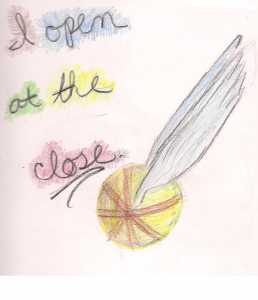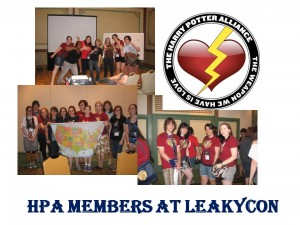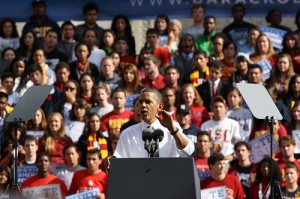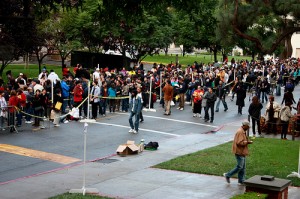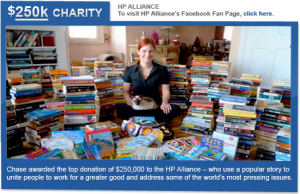The astonishingly rapid and expansive spread of Invisible Children’s Kony 2012 film has garnered immense attention (both positive and negative) online. While much of the criticism is around the organization’s rhetoric, its suggestion of military intervention, or its financial practices, I would like to touch on a different aspect of Invisible Children — its impact as an organization on youth participation in US civic and political life.
Why has Invisible Children’s approach resonated so well with young people and what impact does this and other campaigns have on their sense of themselves as political agents? The Kony 2012 video has been most popular with 13-17 year old Americans (as well as 18-24 year old American males…), and part of the video’s soaring viewership is attributed to these teenagers’ sharing of the video through their various social networks. So far, it would be simple to dismiss their sharing of the video as a form of Slacktivism: these young people, allegedly, are practicing easy and thus meaningless forms of social action, actions that don’t go beyond pressing ‘share’. This critique, however, ignores the possibility that for the millions of young people who watched Kony 2012 and shared it with friends, the movie may be meaningful in mobilizing young people as civic actors. Making such statements around Kony 2012 would be premature, as only time will tell what the long-term impacts of young people’s experiences with this movie will be. But, we can gain some preliminary insights by looking at what Invisible Children has done before, over its years of mobilizing young Americans to action. At this time, we do not want to get into the controversies about the right action to take around the war in Central Africa. Rather, we want to highlight Invisible Children’s ability to powerfully engage young people through what we call Participatory Culture Civics.
Let’s first provide some background. Invisible Children (IC) is an organization that has been around for 8 years. IC’s previous 10 movies, while not circulated as widely as Kony 2012, have sparked similarly intense reactions from many of its viewers. Some of these previous viewers joined what became the “Invisible Children movement”, consisting of volunteer staff, interns, roadies, and local club members in high schools and colleges. These members participated in IC’s large-scale, performative campaigns, including the Global Night Commute, Displace Me and 25, and dedicated time and energy to promoting IC’s causes nationwide. While this was not Invisible Children’s original goal, the organization became increasingly aware of its “inadvertent” role in encouraging American youth’s social engagement. The organization has increasingly focused on this role as part of its action, as exemplified by the “Fourth Estate” event they held in the summer of 2011, an event dedicated to empowering 650 socially active youth to become activists for the causes they care passionately about. The key elements of this event are summarized in the following video.
The Civic Paths Project Research Group, working with Professor Henry Jenkins at the Annenberg School for Communication & Journalism, University of Southern California and supported by the Spencer Foundation, has been looking at Invisible Children as a case study of what we call Participatory Culture Civics: organizations which build on top and harness the strengths of participatory cultures to further their civic goals. Invisible Children sparked our interest due to its innovative and non-orthodox use of media, but even more so, due to the way it created a participatory community around its goal. But we’ll get to that in a moment.
Among the tens of millions (we’ve given up on updating this number) of viewers of Kony 2012 are hundreds of thousands of young people who have joined Invisible Children’s mission long before this film. In 2010-2011, we interviewed 30 such members, who told us about how they learned about Invisible Children and got involved in the organization, and how becoming involved with the group helped shape their identity as civic actors. We talked to members who were relatively highly engaged: interns volunteering to work at IC offices for the summer, roadies, who volunteered 3 months of their lives to tour IC movies around the nation, and leaders of local IC clubs in high schools and colleges. In short, they were young people who dedicated significant time, energy and effort to IC’s cause. Yet in some ways, they are not unlike some of the new viewers of Kony 2012: many were in high school when they first encountered IC, and to many (though not all) viewing the film and becoming engaged with IC was a first experience of taking part in any civic action. We believe that listening to these members’ accounts of their experiences can help us better understand why young people are attracted to Invisible Children and what role the organization has played in the past in helping young people begin to conceive of themselves as political agents. This blog entry is based in our research with Invisible Children and builds on a forthcoming article “Experiencing Fan Activism: Understanding the Power of Fan Activist Organizations through Members’ Narratives” which will be published in the Journal of Transformative Works and Cultures in June 2012.
Creating content worlds – Invisible Children’s storytelling through movie
Our analysis of Invisible Children’s model of youth engagement began with the lens of “fan activism”: forms of civic engagement and political participation growing out of experiences of fandom. We were examining Invisible Children as a parallel to another case study of Participatory Culture Civics: the Harry Potter Alliance, a non-profit organization that mobilizes the Harry Potter fan community toward civic action, using metaphors from the popular narratives. In comparing the two organizations, we found that while the Harry Potter Alliance built on an existing fan community and harnessed a pre-existing content world (a powerful narrative that strongly resonates with members) toward its civic goals, Invisible Children began with a goal–ending the use of child soldiers in the civil war in Uganda–and built a content world around it.
Invisible Children has been creating documentary films since 2004, when they released their first, and for many viewers most powerful, film, Invisible Children: The Rough Cut (watch here).
For an analysis of IC’s transmedia storytelling practices see this piece by fellow Civic Paths member Lana Swartz.
This movie documents IC founders Jason, Bobby and Lauren’s trip to Uganda, where they first learned about the war with the LRA and the existence of child soldiers. In members’ narratives, this movie is attributed with an almost magical effect in transforming their worldview:
“They showed me the film and I remember being so floored like, ‘I cannot believe that this is going on’ and ‘why have I never heard about this.’ I remember something in me shifted that night.” (Ruth, IC intern)
The main strength of the movie to most IC members is the feeling of identification with the protagonists—the three filmmakers and future IC founders, young people not much older than themselves, who go out to Uganda, encounter a social issue and launch a movement:
“The movie is just very raw, and it’s, even though they were older than me they were kids, and you see these kids just go, they see something, they run into a problem and they’re like, OK, now we have to fix this problem.” (Beth, IC intern)
In this respect, the Kony 2012 movie represents a significant shift in point of view and style. If Rough Cut presented the founders as naïve but good-intentioned film students accidentally stumbling onto a war, Kony 2012 shows Jason as a leader of a viable movement and, predominantly, as a father. When he teaches his 5 year old son about Joseph Kony being “the bad guy”, it’s not clear with whom young viewers most identify – with the 30 something old dad, or with the innocent but earnest 5 year-old.
While Kony 2012 was released online, previous IC movies were mostly distributed through “screenings”: 1.5-2 hour long events, taking place in high schools, colleges and churches. In screenings, IC roadies, who are volunteer staff members, show the movie, and accompany it with an introduction and Q&A sessions. Some screenings also include young Ugandan, recipients of IC scholarships in Uganda, who come to the U.S. for a short period of time to tell their own story in screenings. After screenings, audiences were encouraged to donate to Invisible Children, buy its merchandise, as well as become more involved with its local clubs.
This distribution model, of course, reached a negligible audience when compared with Kony 2012. At the same time, the live interaction with the roadies enabled Invisible Children to create a different experience than that possible when watching Kony 2012 online. By supplementing the movies with live interaction with the roadies, Invisible Children could supplement the information given in the movies (e.g., explain the current state of affairs in Uganda), answer audience’s questions (e.g., how are donations used) as well as create contacts between roadies and IC supporters, which were later maintained online. This model, while reaching much smaller audiences, enabled IC to create a more nuanced and informed message, and thus counter some (though not all) of the criticisms it is now encountering.
Accusations of Slacktivism, or, can watching a 30 minute movie make you a social activist?
Part of the critique around the Kony 2012 campaign is that it promotes Slacktivism: a genre of social action that is easy (done with a click of the mouse), comfortable, and thus meaningless. One of the memes that’s been circulating around Kony 2012 presents this critique. This critique already ignores some of the more active forms of participation that are planned as part of the Kony 2012 campaign, such as the “cover the night” events planned for April 20th 2012, in which participants are called to cover their local cities with posters of Joseph Kony. Countless notices have already sprung up for such local events on Facebook (though, arguably, the goal of getting the world to know who Joseph Kony is, has pretty much been achieved).
Beyond that, however, talking to members of Invisible Children shows how previous IC movies indeed played important roles in helping young people become socially active, though not always in clear, immediate ways. Beth’s story is one example of this. When we interviewed her, Beth was an IC intern, in charge of updating their website with news on the war in Uganda. Beth claimed that she used to be an apathetic, selfish kid (though her family had always been involved in aid in Africa). She happened to watch The Rough Cut at a church, where it was shown by a youth pastor. Beth described watching the movie as a formative moment, an embarking on a journey of engagement in activism: “I guess it affects everybody differently. For me there was no way I could do anything else. I couldn’t go get a white collar job […] I don’t even remember what other selfish tracks I was on.” The movie opened her eyes to the world of non-profits, and she began researching them online. She became engaged with the student organization STAND, and is now their local president. Through her work with STAND she reconnected with IC. In the interview, she claimed that she now sees no other alternative for herself but being involved in activism: “That life to me just seems like the kind of life everyone should live, a life where you’re not doing something only for yourself, whatever you’re doing is putting something back into the world”.
Beth’s story exemplifies an element we heard in many IC members’ re-tellings: a narrative of self-transformation. In this narrative structure, IC members often describe their ‘former selves’, before joining IC, in contrast to who they are today. Beth describes her former self as apathetic and selfish, in many ways echoing prevalent stereotypes about disengaged youth. In her narrative, watching the Rough Cut represented a life-changing turning point. Her commitment to social engagement, then, seemed to be created at that moment of realization, “understanding that there’s more to life than the mall” (Beth).
These narratives of members are extremely powerful, though they may not be the full picture of what’s going on. Digging down deeper reveals that many IC members (though not all) had been previously socialized to altruistic values and practices. For example, while Beth understates the significance of her parents’ involvement in aid in Africa to her own activist desire, research shows that parental modeling is a key variable predicting youth civic engagement. Yet the movie served as an important catalyst to civic action, one that allowed Beth to feel that she shifted from selfish child to civic actor. Moreover, we found that seeing IC movies was part of a larger process through which young people could become socially involved.
Even when young people want to create social change, finding ways to get meaningfully involved, particularly in world affairs, is described by many members as a challenge. Many “traditional” non-profits, like the Peace Corps, offer limited possibilities for youth (under 18), and often require extensive voluntary commitments. Other organizations may offer young people ways to become involved, but are perceived as old-fashioned and out-dated, “charities run by middle-aged women” (Edie, IC intern). A key strength of IC, and one that Kony 2012 exhibits as well, is the way it offers young people actionable steps, concrete channels to express a pre-existing activist desire:
“I had been trying to find ways that I could get into volunteering or working to become part of a more global community. I saw the screening and they were in the process of trying to get the bill passed and they were encouraging us to talk to senators to hold a meeting, a cool way that you guys can make a big change, and so I got really involved from there.” (Tina, IC roadie)
While signing an online pledge or purchasing a $30 action kit (which are now completely sold out) may be seen as meaningless steps, for young people they can be perceived as significant first steps in taking civic action, giving them a sense of agency and empowerment that often sparks further action, as Beth’s story shows.
“White man’s burden?” Nuancing the message
One of the accusations against Kony 2012 has accompanied Invisible Children from its start: the accusation of presenting “poor Ugandan children” who “need to be rescued” by white Americans. Invisible Children as an organization has grappled with this accusation and over the years made many attempts to nuance their message. One of the leadership’s key statements is that their relationship with the Ugandans is one of friendship and mutual learning, not only one-directional aid. This message is in fact one that was very peripheral to Kony 2012, but it is strongly echoed in the narratives of members we talked to. IC members repeatedly expressed shared affiliations with the people of Uganda whom they have never met.
“Even though I haven’t met anyone from Uganda, I feel like they’re kind of my extended friends now. I care about them not just a far off, ‘Oh, I want everybody to be okay’ but I really feel somewhat connected.” (Dave, IC intern)
Janelle, an IC intern, is one of few IC members who have visited Uganda. She similarly speaks of a mutual relationship:
“It was such an eye opening experience. You put faces to the people you’re helping, it’s not just helping others but building friendships and exchanging. It was definitely what [the Ugandans] were giving, they were giving to us as well, learning from their culture.” (Janelle, IC intern)
It is still early to tell which relationships toward Ugandans Kony 2012 may invoke in its viewers. In trying to create a movie that people will be compelled to share, Invisible Children may have sidetracked their previous commitment to a nuanced representation of their relationship with the Ugandans. Yet when young people participate in conversations online about whether or not Kony 2012 is a representation of White Man’s Burden, they may be creating such nuanced understanding themselves in active ways that may be particularly effective. In this manner, the movie may again be seen as one aspect of a wider experience through which young people gain awareness of a problem they previously did not know about, become more informed about it, but are also mobilized in concrete and empowering ways.
The message young people are getting (again)
Beyond the specific discussion around Kony 2012, we have, as scholars, a wider agenda.
Part of the criticism that Invisible Children is receiving is a normative and ideological one: it is about what social action needs to look like, who may participate in it, and what it should entail. Bluntly read, what some of critics are arguing is that social advocacy, particularly around world affairs, should be left to experts: to politicians, to “serious” NGOs, to erudites. Young people—and this includes both the film’s 30 something-old creators, and its mostly 20 and under viewers—are told that this isn’t a world for them. It is too complicated, too hard, too serious. These are the same messages young people are getting about politics: If you don’t know exactly what you’re talking about, you’d better not talk at all.
A lot of the criticism of Invisible Children and Kony 2012 can be read as a protecting of boundaries and barriers. Who is and who is not allowed to speak; what is the right way to speak; and what should that sound like. There are many ways to take social action, and there are many other organizations out there that probably do many things better than Invisible Children. They have more nuanced messages, they offer more detailed information, they spend more of their budget on direct aid programs. IC is accused of spending too much money on filmmaking and “marketing”. Yet this statistic is seen in a different light if we consider fostering youth engagement as a central role of what Invisible Children does, as the Fourth Estate youth leadership event implies. When was the last time so many young people were so engaged around any social issue, let alone a war in Africa?
IC belongs to a new genre of civic organization, one that plays with and challenges accepted definitions of social action and what it should look and feel like. Over the past days, many critics have again and again articulated what IC is doing wrong. But in speaking to young people, it is obviously doing something right.
Many critiques of Invisible Children and of Kony 2012 may point to real improvement areas for the organization, and IC will have to meaningfully grapple with these critiques over time. But in addition to pointing out important problems, non-profit organizations, politicians and scholars should also ask, how is Invisible Children able to resonate so strongly with young people? How does it mobilize and get them involved? We suggest that the answer to these questions can be found not only in their film-making but also among IC’s young viewers, supporters and members, who want to speak up – but they need to be spoken to and invited to participate first. Invisible Children is asking them to participate. Are you?


